Nothing ruins a beautiful garden in a more frustrating and efficient manner than a pest invasion. Garden pests generally target plants that are transplants, young, or unhealthy. The weaker the plant, the easier it is for pests to devour. The Texas heat encourages pests to emerge from their overwintering spots earlier than they do in other regions, so it’s important to be aware of the pests that you might see in your yard this year. Let’s examine five of the most common plant pests before we discuss the best ways to prevent them from ruining your home’s greenery.
Aphids
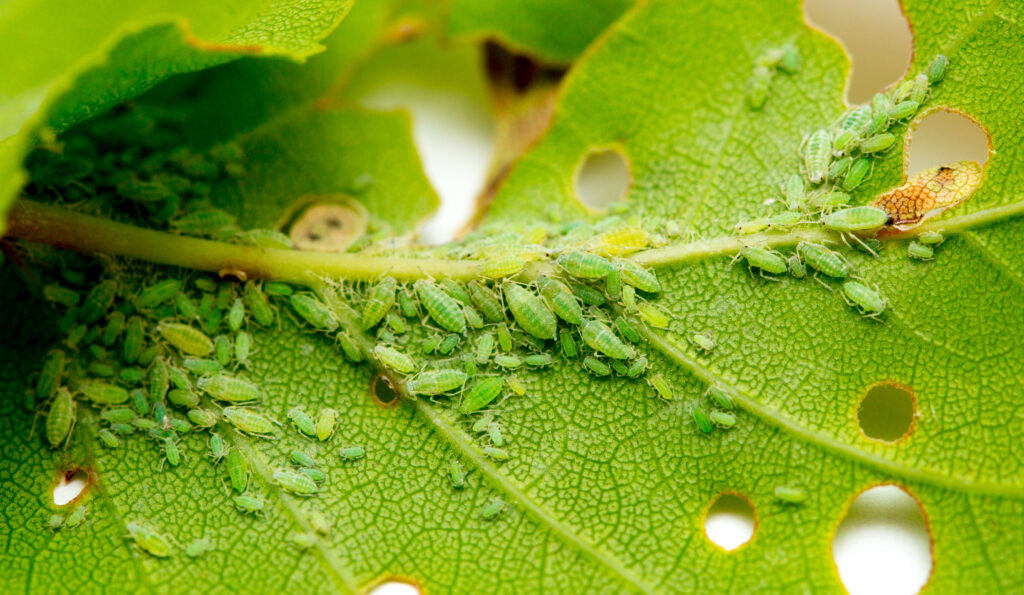
Favorite Plants: hibiscus, crape myrtle, pecan trees, roses, vegetables, oak trees
If you were to survey a random group of people on the most common garden pests, we have a strong feeling that aphids would be one of the most popular answers. This pest is usually green-colored to help them blend in with their favorite plants. Aphids are about 1/8 of an inch long, have soft bodies, and produce a sticky honeydew substance as they eat. Once they pierce the soft leaves with their sharp mouthparts, aphids drink the plant’s sap from the underside of the leaves.
Their massive appetites are bad enough for plant life, but aphids harm greenery in other ways as well. The honeydew they produce blocks the sunlight from completely reaching the plant, which causes sooty mold to grow on the leaves. Another way that aphids gradually kill vegetation is with the toxic secretions they produce in their saliva. The toxins cause the greenery to yellow and lose its leaves before completely withering, so it’s essential to treat an aphid problem as early as possible. Thankfully, aphids have more enemies than friends; ladybugs and lacewings dine on aphids as their main food source!
Cutworms
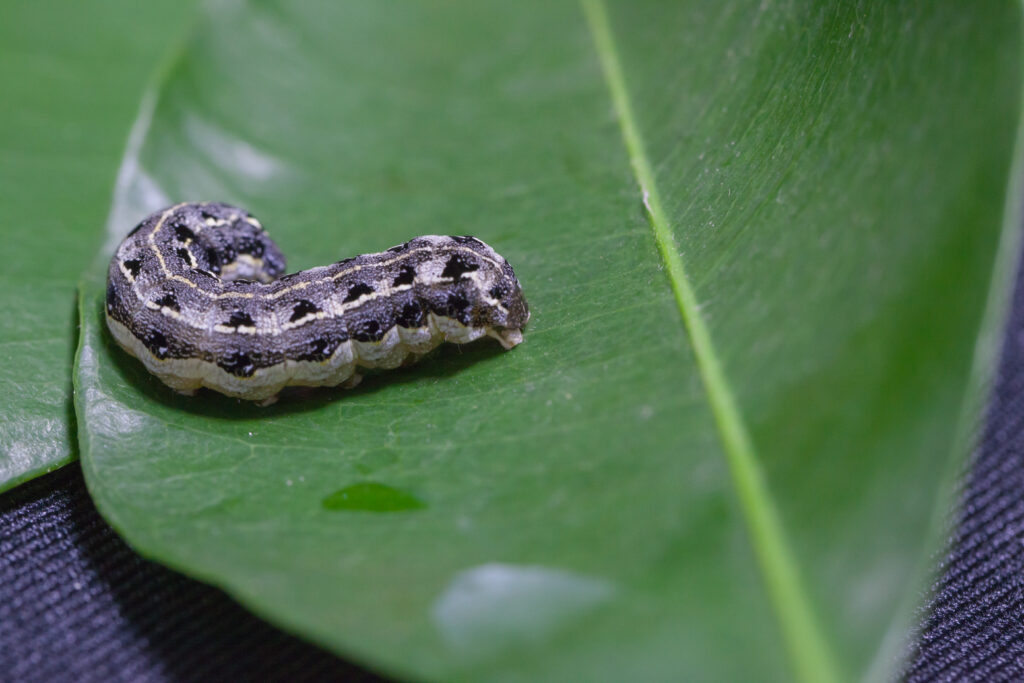
Favorite Plants: seedlings, young plants, transplants, weeds, tomatoes, cabbage, turf
The good news about cutworms is they’re the larval stage of gray moths, so they won’t be this destructive forever. The bad news is that these moths produce three to five generations per year, so cutworms are a dime a dozen. These gray-black larvae are smooth and prefer not to be touched, so they curl into a C-shape when they’re threatened. Since they are nocturnal, cutworms hide in the topsoil and under leaves during the daytime.
Cutworms earned their name based on their strangely intense feeding habits. They target young plants and thin stems because the larvae use their strong mouths to “cut” through them easily. Young sprouts can’t recover from this feeding because their stems are cut through, like they’re trees that were sawed down. The typical evidence of this pest’s presence is the state of the garden during the day. If you find any toppled plants or bare spots where new vegetation used to be, it’s likely the nighttime work of cutworms.
Spider Mites
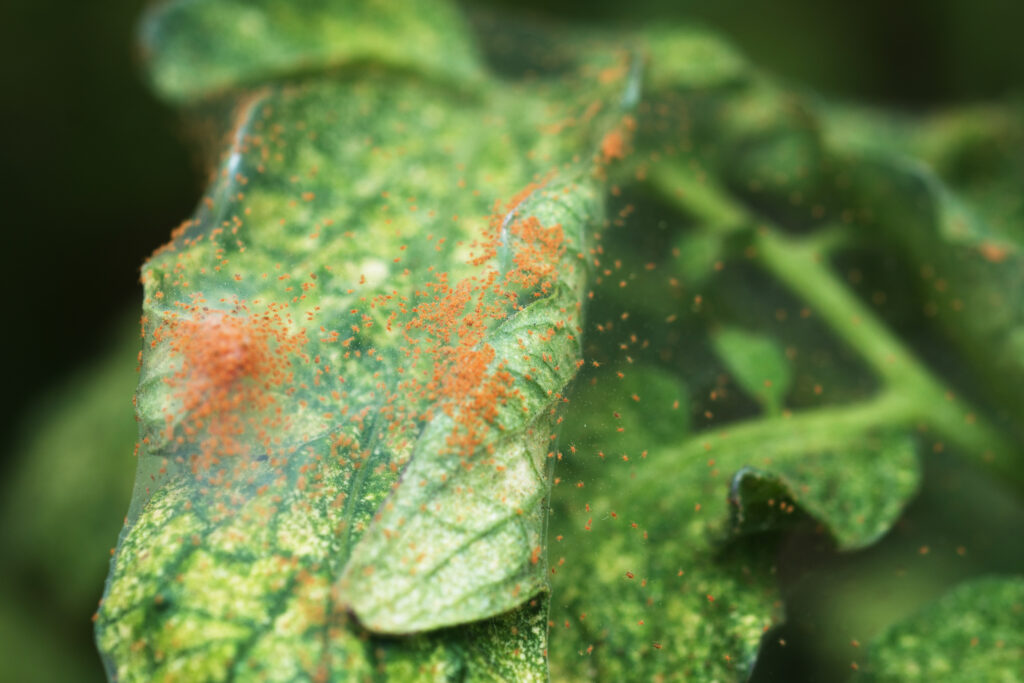
Favorite Plants: strawberries, tomatoes, roses, house plants, fruit juices
Spider mites are indeed related to spiders, but they are even more destructive than their creepy cousins. These mites are bright red and have eight legs, so they can scurry across a leaf quickly despite their tiny size. They also produce a bit of silk webbing on the vegetation they invade, so finding their wispy webs is one of the first signs of an infestation. As spider mites feed, they gain enough nutrients to produce countless eggs on the underside of leaves and the top of buds.
Despite their minuscule size, spider mites are devastating in large numbers. Their activity peaks from July through September because the summer heat gives them enough energy to chomp on plants. A spider mite invasion is usually discovered because the leaves on an infested plant lose health quickly. A plant drained of life develops spots (usually yellow or gray) on its leaves and loses those leaves entirely after a while. An easy way to tell if an unhealthy plant has spider mites is to give it a quick shake over a white paper towel, so the red pests stand out!
Japanese Beetles
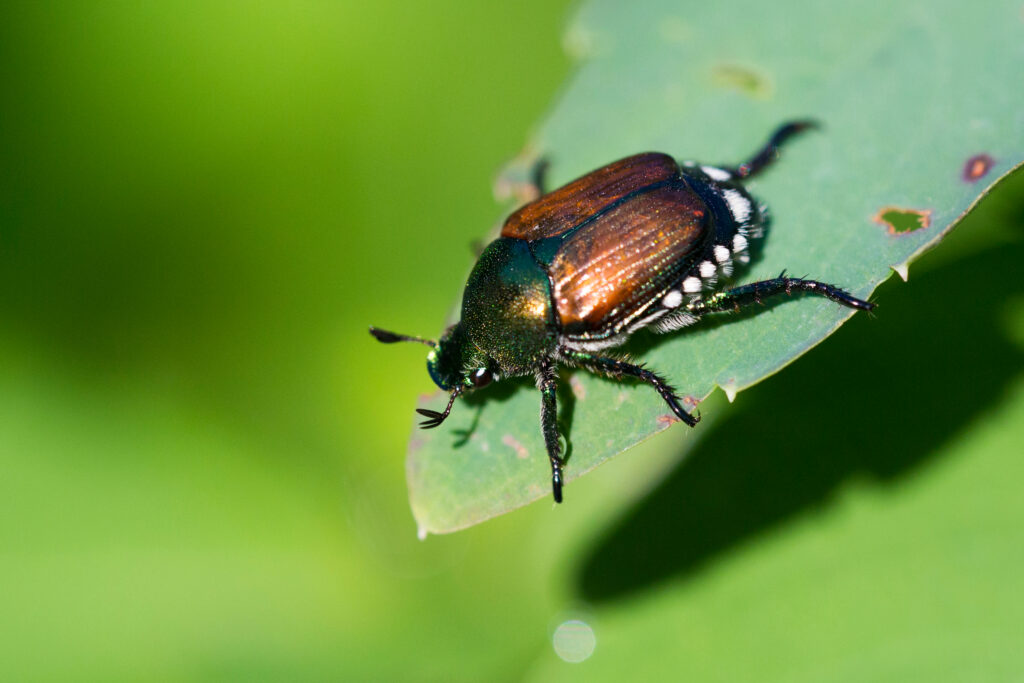
Favorite Plants: leaves, petals, grapes, raspberries, roses, elms
These pests are one of those annoying types that are common in many states, but most people don’t know what they’re called. Well, these shiny beetles are Japanese beetles, and they’re most active from late June through early October. They are usually green with golden wing covers, about 1/2 an inch long, and voracious eaters. Japanese beetles spend most months in their larval state. The white grubs eat roots since they live just below the surface and have access to the plant’s life source.
If the weather stays warm early in the year, the adult beetles start their feeding and reproducing processes sooner than usual. Japanese beetles place their eggs in watered lawns in order to give their offspring a better chance at surviving. The adults start feeding on plants late in the growing season, long after crops begin producing their fruits and vegetables. Thanks to their insatiable appetites, Japanese beetles chew huge holes in leaves until they are too weak to stay on the plant. A plant with skeletonized leaves — and fewer leaves in general — was likely the main course of a Japanese beetle family’s meal.
Pillbugs
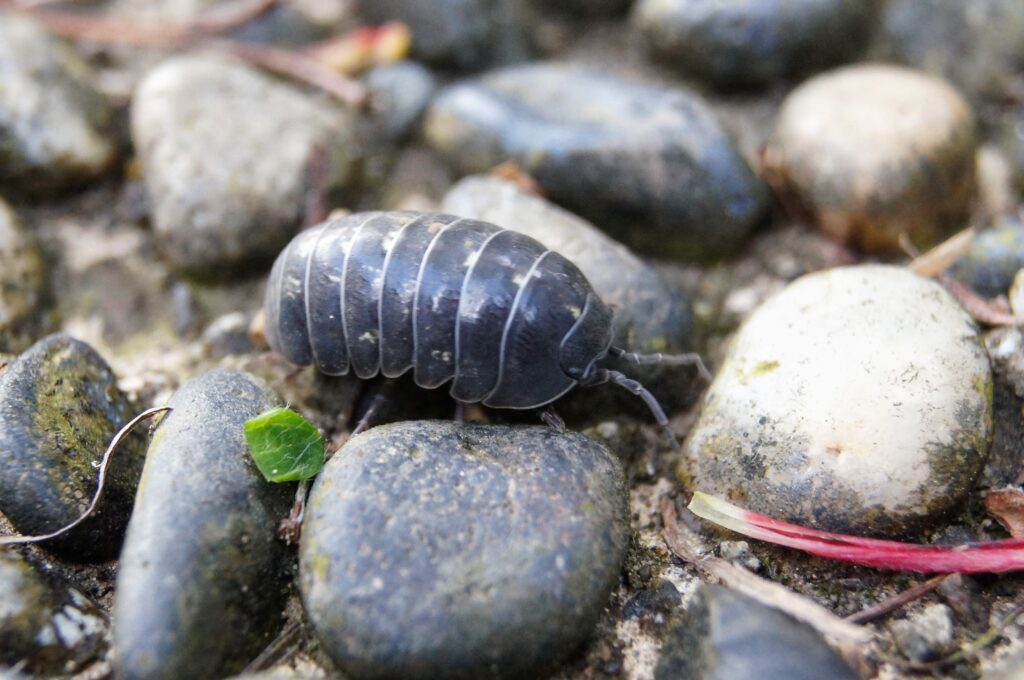
Favorite Plants: strawberries, melons, squash, peas, most vegetables, grass, roots, stems
Children affectionately call this pest a “roly-poly” due to the critter’s habit of rolling up into a ball when it’s touched, but it is officially known as the pillbug. It is about 3/8 of an inch long and lives for up to three years. This pest is a bit different than the others. For one, it is actually a crustacean that is more related to lobsters than ladybugs! Another difference is what the pillbug actually eats. They are definitely garden pests, but pillbugs also eat decomposing organic matter.
This diet helps the ecosystem by breaking down old organic matter at a quicker rate, so the problem lies in the fact that they don’t strictly feed on dead plants. Pillbugs commonly live in gardens for the moist soil, which places them closer to our precious plants. They hide under natural objects during the day to shelter themselves from the harsh sun. Pillbugs eat any plant matter they find at night, including young plants and small vegetables. They produce three groups of offspring per year, so pillbug families invade gardens and start ruining new plant life as soon as they can.
Prevent & Protect Your Garden

The art of protecting your garden and yard from Texas pests is based on your basic yard care. A yard full of healthy vegetation that are properly watered and pruned is less likely to experience a pest infestation than a yard with stressed plants. That being said, pests are nothing if not persistent. They will invade any outdoor space regardless of its current state. But by caring for your greenery and keeping an eye out for pest issues, you can protect your plants from these hungry critters!
The most efficient ways to prevent pests in your yard and garden are:
- Give your greenery the proper amount of water. Any plants, grass, and flowers that are overwatered or insufficiently watered get stressed and are vulnerable to pest attacks.
- Remove weeds from the ground. When there’s a lot of weeds in the soil, garden pests have even more hiding spots in between their feedings.
- Use native plants. Vegetation and crops native to your region are naturally equipped to handle the weather conditions, which means they stand a better chance against a pest infestation.
- Fertilize the lawn. A healthy lawn is a strong lawn, so fertilizer keeps the grass safe from hungry pests and dangerous drought.
- Spray infested plants with water. If you find an army of pests crawling on a plant, spraying a strong stream of water from the hose is an easy way to remove all the pests at once.
- Mow the lawn regularly. When the grass is consistently trimmed to am appropriate length, it provides way less food and shelter for insects than when it’s overgrown.
- Monitor the yard. Finally, looking around your yard for any signs of pest activity is a good daily habit to have, especially in the warmer months.
Romney Puts The Life Back In Your Yard
When pests are bugging your blooms, Romney Pest Control is here to help! Our team of highly-trained technicians is dedicated to keeping your home pest-free. We use a customized combination of treatments to solve each pest issue as safely and efficiently as possible. Whether you’re looking to prevent pests or needing a solution to your current pest problem, we guarantee that our efficient products will keep you pest-free. Contact us today for more information on our thorough services and how Romney kicks garden pests to the curb.
Citations
ABC13. (2012, July 16). How to control Japanese beetles. ABC13 Eyewitness News. Available at https://abc13.com/archive/8737655/ (Accessed on February 21, 2024).
Common diseases & pests in your central Texas landscape. (n.d.). Emerald Lawns. Available at https://emeraldlawns.com/common-diseases-pests-in-your-central-texas-landscape/ (Accessed on February 21, 2024).
Drees & Wickstein. (1990). Sowbugs, pillbugs. Texas A&M AgriLife Extension: Field Guide to Common Texas Insects. Available at https://texasinsects.tamu.edu/sowbugs-pillbugs/ (Accessed on February 21, 2024).
Javed, T. (2023, April 14). 9 worst garden pests in Dallas, TX. LawnStarter. Available at https://www.lawnstarter.com/blog/texas/dallas-tx/worst-garden-pests-dallas/ (Accessed on February 20, 2024).
Managing 10 common Texas yard pests. (n.d.). Take Care of Texas. Retrieved February 20, 2024, from https://www.cityofirving.org/DocumentCenter/View/11600/Urban-Gardening—Insect-Control-Guide?bidId=
Stewart. (1985). Cutworm. Texas A&M AgriLife Extension: Field Guide to Common Texas Insects. Available at https://texasinsects.tamu.edu/cutworm/ (Accessed on February 21, 2024).




